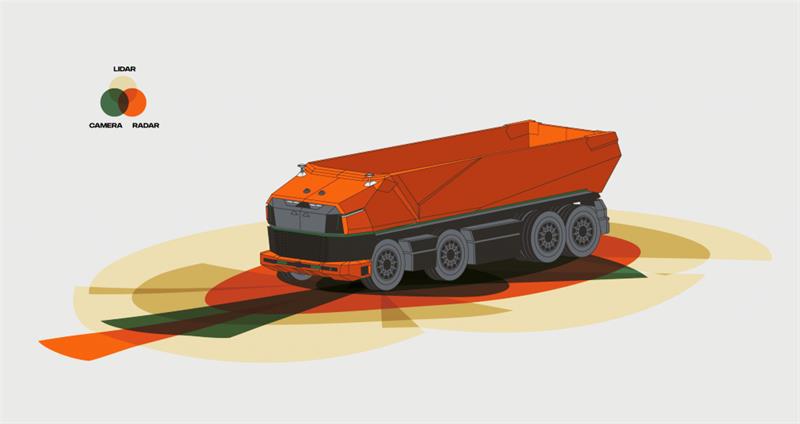Volvo’s autonomous road tractor, Vera, pictured, is currently in testing before being delivered for a trial hauling containers with the Swedish shipper DFDS, on a 5km journey partly on public roads.
The vehicle is the product of completely rethinking the way that goods are transported, according to Volvo’s autonomous solutions vice president Mikael Karlsson. He says: “We’re trying to put ourselves into the future, and not merely making a linear extrapolation of what we have now. We are looking into those specific segments where we think that automation will have a relevant role to play, and it is typically repetitive flows very much similar to production lines where we have a high people transport or high capacity need.
“What we have today is a truck, which in many ways is designed around a driver, and if the driver disappears, then from a selling point of view you don’t really need good storage in the cab, you don’t need a shiny exhaust pipe, high horsepower or the other things that appeal to the drivers. In many ways the business model changes, the working conditions change and the design changes as a consequence.”
The major advantage of the system is cost savings, as its estimates suggest that the driver accounts for about 30% of operational cost.
He compares a transport system that includes automated vehicles with a ski lift. “You build a ski lift where it’s relevant; you don’t usually build it where there’s no snow. And it’s the same with automation; you need to have a relevant need for high transport and capacity that could be captured.” He says that it’s Volvo’s vision that autonomous transport networks will grow first in these particular environments, either within industrial sites, or between them and distribution centres. “It’s more of a system. Because what we do today is we sell trucks that are like a Swiss Army knife; they could be used for anything. They can haul timber, they can do concrete mixing. This is more purpose-built to do a specific task in a specific area.”
DRIVELINE CHOICE
Karlsson says that an electric driveline made perfect sense in this application. He explains: “First of all, the efficiency on an electric driveline is much better, especially if you run it at slower speeds. And the efficiency conversion is up to four times better. And then obviously it’s easier to refuel or recharge with an electric vehicle because you can do that automatically. If the electricity is from a green source, you will have a much better proposal when it comes to CO2 emissions. And it is quiet, so if your operation is from a warehouse or from a factory, then you can run from inside the warehouse to the next destination without having any disturbances.”
To prevent problems on the road, the vehicle is equipped with an array of 19 road sensors: three LiDAR (light detection and ranging), five radar and 11 cameras, feeding data to and from a nearby control tower. The 4x2 vehicle guides itself along a path through a map that it also creates; Volvo has partnered with Nvidia to help with the enabling AI technology.
Two 185kW (peak) electric motors, the same model used in a Volvo electric city bus, are driven by electricity stored in three or four on-board batteries. For safety’s sake, steering, braking and power supplies are redundant. Expected to have a 100km operational range, the vehicles would run 24 hours a day, pausing only for a 30-minute recharge carried out by parking the vehicle over a non-contact inductive charging loop.
INFRASTRUCTURE CHANGES
The next step, he states, is to work with local authorities to plan and prepare road infrastructure for the first exemplary system. Farther in the future, Volvo imagines using autonomous vehicles on the highway, shuttling between distribution centres.
Just as innovative as the systems thinking approach and the technology is the contractual structure: Volvo won’t sell these as individual units, but price up the entire system and charge as a service, per unit moved. For example, Volvo is charging Norwegian chalk mine operator Brønnøy Kalk per tonne produced to operate six FH16 tractors. The trucks, hauling articulated tipper trailers, travel three miles (5km) from mine to crusher.
Karlsson adds: “It’s big logistics companies that have a high need for transport. They are usually seeing a certain investment over time, and are looking at total cost of ownership.
“We will have these kinds of service models for this because this is how we can be relevant when it’s not a feature-driven business,” explains Karlsson. “They are not asking for owning options or for fiddling around with the trucks; they want to have a seamless flow, a trouble-free transport solution.”
BOX: CABLESS TIPPER
Scania has revealed designs of a cab-less autonomous four-axle concept truck, AXL, intended for mines and large construction sites. The vehicle is powered by a gas engine. A combined sensing array using camera, radar, GPS and LiDAR (light detection and ranging) technologies (diagrammed below) help position the vehicle in space and detect obstacles.

“We already have self-driving trucks in customer operations. However so far, they have been with room for a safety driver who can intervene if necessary. Scania AXL does not have a cab and that changes the game significantly,” says Claes Erixon, head of research and development at Scania.
Although the AXL is not yet in operation, a real-life example of an autonomous vehicle in action is a trial involving a modified Scania XT 8x4 tipper with safety driver. It began in August 2018 at the Rio Tinto Dampier Salt mine in Western Australia, where the vehicle is working separately to the mine’s traditional hauling vehicles.